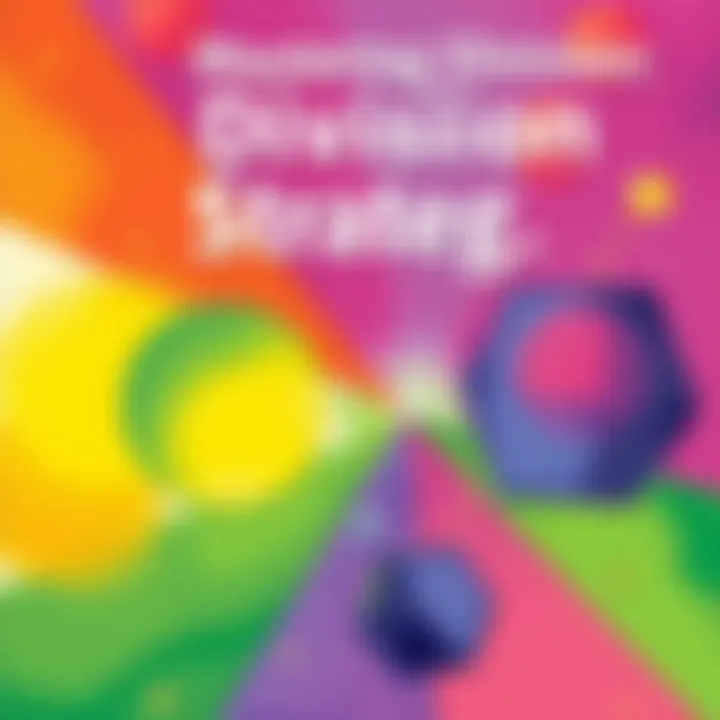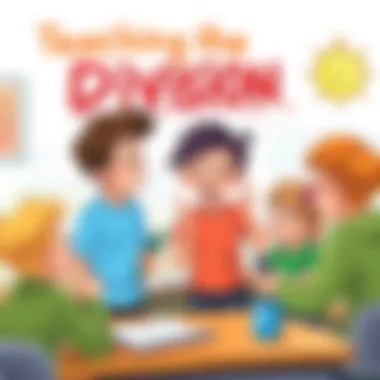Mastering Division: Strategies and Practical Techniques


Intro
Division might seem like a straightforward operation in mathematics, but its significance stretches far beyond just numbers. Understanding how to divide not only lays the groundwork for higher-level mathematical concepts but also finds its roots in daily life. Whether splitting a pizza among friends or distributing time between tasks, division plays a crucial role. The objective of this article is to break down the art of division, providing strategies, techniques, and insights tailored to parents, educators, and caregivers. By examining various aspects—from interactive learning games to effective teaching tips—we aim to equip you with the necessary tools to foster a strong grasp of division in children aged three to twelve.
Interactive Learning Games
When it comes to learning division, children often benefit from interactive experiences that make the process more appealing. Engaging games can turn what may seem like a tedious task into a fun challenge, sparking curiosity in young minds.
Popular Games
Several games have gained traction among educators and parents alike for their educational value. These include:
- Math Bingo: A twist on the classic bingo game, where participants solve division problems to mark their cards.
- Division Jeopardy: A game formatted like the show Jeopardy, focusing on division-related questions across different difficulty levels.
- Prodigy Math: An online game that integrates curriculum-based math concepts, including division, within an immersive fantasy world.
Description of Top Educational Games
- Math Bingo: Players receive cards filled with answers to division problems. As questions are called out, children solve them for a chance to shout “Bingo!”—the interactive nature keeps them engaged.
- Division Jeopardy: Teams compete to answer division questions from various categories, promoting teamwork while reinforcing math skills through friendly competition.
- Prodigy Math: This game uses a fantasy theme to teach math. Kids complete math questions, including division, to progress in the game, making learning feel more like play.
Benefits of Playing Educational Games for Kids' Cognitive Development
Educational games serve multiple purposes. They not only reinforce division skills but also enhance problem-solving abilities and critical thinking. These games usually encourage collaboration, improving social skills too. Additionally, they foster a positive attitude toward learning, establishing a foundation for lifelong education.
Game Reviews
In-depth Reviews of Selected Educational Games
- Prodigy Math: This game effectively combines entertainment with education. Players are immersed in a richly designed world where they tackle division problems in various formats. It appeals to a broad age range and adapts to each child's learning speed.
- Division Jeopardy: An excellent tool for classroom settings. The interactive format keeps kids alert, while the competitive atmosphere motivates them to perform better. However, proper setup is necessary to ensure a smooth flow during gameplay.
Comparison of Gameplay and Learning Outcomes
While different in their approaches, all these games emphasize division principles. Prodigy's adaptive mechanism targets individual educational needs, while Math Bingo offers quick-paced learning, solidifying knowledge through repetition and fun. Overall, integrating these games into learning routines can dramatically enhance children's understanding and retention of division concepts.
Tips and Tricks
Implementing effective techniques can help parents and educators streamline the teaching of division. Here are a few practical suggestions:
- Incorporate Visual Aids: Use visual tools like pie charts or number lines to help illustrate division concepts.
- Relate to Real-Life Situations: Create scenarios that kids can relate to, like sharing candy or dividing toys, to make division feel relevant and approachable.
- Incremental Teaching: Start with simple problems; gradually introduce more complexity as confidence builds.
These strategies aim to make learning enjoyable while also ensuring children fully grasp the concept of division.
Creative DIY Projects
Hands-on activities can amplify learning experiences and reinforce division principles organically. Engaging in DIY projects allows children to express creativity while learning.
Step-by-Step Guides
Creating engaging DIY projects involves:
- Mason Jar Money Bank: Use a jar to collect coins while dividing them among family members at holiday times to teach division practically.
- DIY Division Board: A board to create various division problems using physical objects. Kids can manipulate these objects to find solutions, making math more tangible.
Craft Ideas
Using commonplace items, craft projects can focus on division:
- Cut-Out Cookies: After baking, kids can cut the dough into pieces, allowing them to practice dividing a whole into parts.
- Paper Chains: Create chains of a specific length, practicing how to divide into equal segments.
Artistic projects not only help develop fine motor skills but also enhance understanding by letting kids visually see the results of division.
Understanding Division
Division often takes a backseat to addition and multiplication in early math education, yet its importance cannot be overstated. Recognizing how division works lays the groundwork for various aspects of mathematics and everyday life. This section seeks to highlight the crucial elements of division, discussing its role not just as an operation but as a fundamental concept that underpins much of what we do in math and beyond.
The Concept of Division
At its core, division is one of the four basic arithmetic operations alongside addition, subtraction, and multiplication. It signifies the process of splitting a whole into equal parts. Imagine you have a pizza cut into eight slices. If you share this delicious pizza among four friends, each person gets two slices. This real-world scenario serves as a quintessential example of division in action, represented mathematically as 8 (the total number of slices) divided by 4 (the number of friends sharing it), resulting in 2 slices each.
In some cases, division is perceived as a way to find how many times one number fits into another. This leads to new perspectives and applications, making division a valuable skill beyond rote memorization.
Importance of Division in Mathematics
Understanding division is foundational for various mathematical concepts. Without this understanding, grasping advanced topics becomes a daunting task. Here are a few reasons why division plays a far greater role in math education:
- Building Blocks for Fractions: Division introduces the concept of fractions. Consider 1 divided by 2, which gives you the fraction (\frac12). Without division, it would be impossible to understand and work with fractions, which are paramount not only in math but also in real life—like cooking or budgeting.
- Problem Solving: Division is integral to problem-solving strategies. It teaches logical thinking. For example, if you're faced with a project that requires distributing tasks among a group, division helps to figure out how many tasks each person is responsible for.
- Preparation for Algebra and Beyond: Division paves the way for more complex mathematics, such as algebra. Many algebraic expressions include division, which serves to manipulate equations.
- Real-World Applications: Division is encountered daily, from calculating costs during shopping to determining time management. It fosters critical thinking in making decisions.
Effective mastery of division opens doors to higher reasoning in mathematics and promotes stronger capabilities in tackling day-to-day challenges.
Emphasizing the importance of division not only enhances mathematical education but also equips children with the skills necessary to navigate their world adeptly. Understanding division is not merely about learning how to divide; it’s about fostering a deeper understanding of relationships between numbers, thus aiding children in their educational journey.


Basic Division Principles
Understanding the fundamental principles of division is crucial for grasping more complex mathematical concepts. This section focuses on Dividends and Divisors as well as clarifying The Quotient, which are the key components that make division not only simpler but also more intuitive.
Dividends and Divisors
In any division problem, we encounter two primary elements: the dividend and the divisor. The dividend is the number being divided, while the divisor is the number by which we are dividing. Let's consider an example: if you have twelve apples and you want to divide them among four friends, twelve is the dividend, and four is the divisor. The way we structure this is simple: 12 ÷ 4 = ? Here, the equation signifies that we’re trying to find out how many apples each friend will get.
By understanding the roles of dividends and divisors, children can appreciate that division is fundamentally about sharing. Not all division will yield whole numbers. If we think about sharing three apples amongst four friends, we end up with fractions or decimals, which introduces a broader concept of division. Teaching children about how dividends and divisors interact not only enhances their numerical skills but also enhances their real-life perception of sharing and fairness.
The Quotient Explained
The quotient is the result we get from dividing the dividend by the divisor. In our previous example, if twelve apples are shared among four friends, each friend receives three apples, which makes three the quotient (12 ÷ 4 = 3). This is the ultimate goal of division—understanding what that division means in practical terms.
To further cement this idea, you might engage in some simple exercises using real-life objects like candies or toys. Ask the child to divide a set number of items among friends and ask, "How many does each person get?"
It's also important for learners to see division in action through word problems. For instance, you can present a scenario where a teacher divides a class of twenty-four students into groups of six. The question would be, "How many groups will there be?" This not only reinforces the concept of quotient but also enhances problem-solving skills, teaching children how to take abstract concepts and apply them in the real world.
By instilling an understanding of these basic principles, learners will build a solid groundwork for tackling more complex arithmetic challenges in their future endeavors.
"Understanding the basics of division lays the foundation for advanced mathematical reasoning and problem-solving."
Ensuring a grasp of dividends, divisors, and the quotient is essential for young learners as they journey through their mathematical education.
Division Algorithms
When tackling division problems, understanding division algorithms is crucial. These algorithms offer systematic approaches to solving division, ensuring clarity and accuracy in results. For learners—especially children—these methods are foundational. They enhance both comprehension and problem-solving skills.
Employing division algorithms can help students visualize the process, breaking down complex problems into manageable parts. This is particularly important in today's fast-paced educational environment, where many learners benefit from structured methods that cater to diverse learning styles. Furthermore, effective teaching of division algorithms encourages confidence in mathematical abilities.
Long Division Method
Long division stands out as a significant method for finding the quotient of larger numbers. This technique requires patience and a step-by-step approach. At its core, the long division method breaks down the division process into a series of simpler calculations, making it easier for children to grasp the concept.
When using long division, the dividend is placed inside the division bracket, while the divisor sits outside. The process begins by examining how many times the divisor can fit into the leading digits of the dividend. This leads to several key steps:
- Divide: Find how many times the divisor fits into the number.
- Multiply: Multiply the divisor by this result.
- Subtract: Subtract the result from the dividend.
- Bring down: Take down the next digit of the dividend.
- Repeat: Continue this process until all digits are used.
This method not only reinforces basic arithmetic skills but also prepares students for more advanced mathematical concepts. As they practice long division, they develop a sense of numerical relationships and problem-solving strategies that will serve them well in future math challenges.
Tip: Encourage practice with a variety of problems, gradually increasing complexity. This will help cement the process in their minds.
Short Division Technique
Short division, often considered a more streamlined approach, is ideal for simpler calculations. While it may not be suitable for larger numbers, this method allows students to perform division quickly and often mentally. In short division, the basics remain the same, but it simplifies some steps by omitting certain calculations.
In this technique, students write the dividend and divisor and consider the quotient for each digit of the dividend. For example, in dividing 144 by 12:
- Start with the first digit: See how many times 12 can fit into 1. (It doesn’t fit; go to 14.)
- Next, consider 14: 12 fits once (1). Write 1 above the line.
- Subtract: 14 minus 12 equals 2. Bring down the next digit (4) to make 24.
- Repeat with 24: 12 fits twice (2). Write 2 above.
- Final Subtraction: 24 minus 24 gives 0; end of division.
Short division is particularly beneficial for quick estimations or mental calculations. It keeps students engaged without the overwhelming steps often involved in long division. Teachers can emphasize this method for daily math tasks like sharing equally among friends, thus grounding the concept in real-life applications.
In both methods—long and short division—practicing different problems enhances retention and builds a solid mathematical foundation that serves students well throughout their educational journey.
Visualizing Division
Visualizing division is a powerful educational tool that enhances understanding, especially among younger learners. It transforms abstract mathematical concepts into tangible ideas. Kids often struggle with division simply because they can't see how it works in a real-world context. By turning division into something they can see and manipulate, we create pathways for deeper comprehension.
Incorporating visual methods helps solidify a child’s grasp of division. It allows them to transition from rote memorization of rules to intrinsic understanding. Here, we will explore two effective visual strategies: arrays and number lines, which not only elucidate the process of division but also enhance a child's engagement with math.
Using Arrays for Understanding
Arrays serve as a brilliant visual method for helping children grasp division. An array organizes objects into rows and columns, making it easier to conceptualize how division splits a larger quantity into smaller groups.
For instance, let's consider dividing 12 apples among 3 friends. You can set up an array with 4 rows and 3 columns:
- Row 1: 🍏 🍏 🍏
- Row 2: 🍏 🍏 🍏
- Row 3: 🍏 🍏 🍏
- Row 4: 🍏 🍏 🍏
From this arrangement, each row can be seen as one friend receiving 4 apples. Thus, the visual pattern correlates perfectly with the division problem: 12 apples divided by 3 friends equals 4 apples each. This method not only clarifies the division process but also taps into children’s visual learning style.
By using items they can feel, see, and count, children are likely to remember these concepts much easier. Here are some benefits of using arrays:
- Hands-on Learning: Kids can manipulate objects to see the division process, making it fun.
- Connection to Multiplication: Arrays also reinforce multiplication concepts, creating a well-rounded understanding of these fundamental operations.
- Engagement: The physical presence of objects keeps children interested and focused.
Number Lines in Division
Another effective strategy for visualizing division is using number lines. Number lines provide a linear representation that can help children understand how many times a number can be subtracted from another number until zero is reached. This method is particularly effective for teaching division as repeated subtraction.
For example, if we take 15 and want to divide it by 5, a child can use a number line to show this:


- Start at 15.
- Draw a jump of -5.
- Repeat this step until reaching zero.
The jumps would look as follows: 15 → 10 → 5 → 0. Each jump signifies one divison operation. In this case, a child would see that 15 divided by 5 results in three jumps, thus confirming that 15 divided by 5 equals 3.
Here are some advantages of using number lines:
- Visual Representation: It offers a clear visual path that demystifies the number of times a divisor fits into the dividend.
- Promotes Understanding of Division as Repeated Subtraction: It explicitly shows how division is related to subtraction, enhancing mathematical connections.
- Flexible Application: Number lines can be used for both whole numbers and fractions, making them versatile tools in teaching division.
"Visual methods not only clarify but also empower children, allowing them to see math in action."
By employing arrays and number lines in educational practices, parents and educators can provide children with vital tools for mastering division. Not only does this approach strengthen their mathematical foundations, but it also prepares them to tackle more complex equations down the line.
Applying Division in Real Life
Understanding how division operates is not just a value added in the classroom; it resonates throughout various aspects of life. This section will explore why applying division in real-world contexts is essential. Without a doubt, mastering division allows individuals to make informed decisions, manage tasks efficiently, and understand numbers in a practical sense. Equally important, gaining a real-life perspective on division enhances educational outcomes, engages learners, and makes mathematics relatable and meaningful.
A significant benefit of employing division in everyday activities is that it fosters critical thinking. When children see real-world examples of division, they develop the ability to analyze situations, identify numbers to work with, and break problems down into manageable pieces. This real-life application lends a practical edge to abstract concepts. Consequently, division transforms from mere classroom arithmetic into a versatile cognitive tool.
The importance of applying division also extends to financial literacy; whether it's splitting costs among friends during an outing or determining the correct amount of ingredients when cooking, division comes into play. Through such scenarios, children learn how to budget, compare costs, and even understand value for money. Furthermore, these experiences impeccably illustrate the connection between mathematics and daily obligations, actively promoting a wider appreciation for numerical skills.
"Mathematics is not a numbers game; it's a way of thinking."
Division in Daily Activities
When it comes to division in daily activities, the examples are abound. Take a moment to consider the process of sharing a pizza, for instance. Imagine a group of four friends deciding to order two pizzas. Each pizza can be sliced into eight pieces. Thus, understanding division allows them to determine how many pieces each friend will receive when they share the pizza equally. In this case, not only does division solve the immediate problem of sharing food, but it also introduces the concepts of fractions and ratios.
Some common scenarios where division can shine include:
- Splitting Expenses: When two or more people are on a trip, dividing costs like accommodations and meals is essential for fairness.
- Portioning Recipes: If a recipe calls for an ingredient that serves four and you only want to serve two, division helps you calculate the correct amounts.
- Scheduling Time: If someone has two hours available in their day and they want to see how many 15-minute tasks they can fit in, division will quickly illuminate that answer.
Practical Scenarios Involving Division
Real-life situations often require quick and accurate division skills. Here, we will discuss a few practical scenarios that underline the significance of division.
- Sports and teams: During a soccer match, if there are 22 players on the field and you want to find out how many players are on each team, you can use division to determine that there are 11 players per team. It’s a basic application but connects directly to sports, helping children comprehend teamwork and organization.
- Gift Allocation: When organizing gifts for a birthday party, if there are 18 gifts and 6 children, division determines that each child can receive three gifts, ensuring everyone gets a fair share. This scenario ties in themes of generosity and fairness, which are crucial for social development.
- Travel Decisions: When planning a road trip with friends, if the group travels 300 miles and wants to complete the journey in five days, division can assist in identifying a daily travel goal of 60 miles. This measurable approach helps students practice goal-setting, responsibility, and forward planning.
To sum it up, incorporating division into everyday activities opens doors for practical learning experiences, enhancing children’s problem-solving skills and engaging them in the black and white of numbers far beyond the classroom. Whether through sports, budgeting, or sharing, division remains a vital skill that lends balance and fairness in many situations.
Teaching Division to Children
Teaching division to children is not just about introducing them to a mathematical operation; it’s a gateway to fostering critical thinking and problem-solving skills from a young age. Understanding division forms a key part of their mathematical foundation, setting the stage for more complex concepts that they will encounter later in their education. Children who grasp division are better equipped to tackle everyday situations that require numerical reasoning, from sharing snacks evenly among friends to splitting expenses in a group.
The benefits of teaching division early are manifold. First, it encourages logical reasoning. When children divide a set of items, they learn to think methodically about how numbers relate to one another. They begin to see patterns and develop their abilities to manipulate numbers, which is essential in advanced mathematics.
Moreover, division aids in the development of patience and perseverance. Children often face challenges in understanding division, especially when dealing with remainders or fractions. Navigating through these challenges helps them cultivate a tenacity that will serve them well beyond the math classroom. It's about nurturing a growth mindset, where making mistakes is viewed not as a failure, but as a valuable learning opportunity.
Careful consideration should be given to teaching methods, as not every child learns in the same way. Multiple approaches cater to various learning styles, ensuring that all children have an opportunity to understand and appreciate division.
Engaging Teaching Strategies
To instill a solid understanding of division in children, educators can employ a variety of engaging teaching strategies that resonate with young learners. One effective way is through the use of manipulatives, which can take the form of physical objects such as blocks, coins, or counters. For instance, if a child has twelve blocks and is asked to divide them among four friends, physically moving the blocks can provide a clear visual representation of what division looks like.
Visual aids also play an important role. Charts or colorful diagrams can illustrate the division process in a straightforward manner. For example, presenting division as the act of grouping items visually helps children grasp the underlying concepts without feeling overwhelmed by abstract numbers.
Additionally, storytelling can serve as a valuable tool. Incorporating division into scenarios that children can relate to—like sharing toys or dividing treats—helps to contextualize the math, making it more relatable and enjoyable. When children encounter division through stories, it often becomes a memorable experience, enhancing their grasp of the topic.
Utilizing Games and Activities
Games and activities can turn learning division into a fun and competitive experience. One popular game is Division Bingo, where children fill out bingo cards with division problems, and the teacher calls out the answers. This not only reinforces their division skills but also keeps them engaged and motivated.
Another idea is to organize a Division Scavenger Hunt, where children search for items in pairs that they can divide among themselves. This kinesthetic approach allows them to physically engage with the concept while having fun outdoors or in a classroom setting. It marries movement with learning, reinforcing the idea that division is not just about numbers, but also about sharing and collaboration.
To further enhance learning, educators can leverage digital games that focus on division. Platforms like Khan Academy or Prodigy Math offer interactive games that adapt to a child's skill level, providing personalized learning experiences. Such games encourage children to take charge of their own learning, reinforcing their division skills while keeping the process enjoyable.
Engaging children in division through various strategies not only sharpens their mathematical skills but also cultivates a love for learning. Implementing these techniques helps children view division as an exciting challenge rather than a daunting task, turning the learning experience into a constructive and enjoyable journey.
"The art of math is not just in solving problems, but in discovering the connections that make sense of them."
For more insights into using games and fun activities for teaching, you can check resources on edutopia.org or teacherspayteachers.com. These platforms provide a wealth of materials and ideas tailored towards engaging teaching techniques.
Common Division Challenges
Division, while a fundamental mathematical concept, can often present hurdles for learners at various stages. Recognizing these challenges is crucial for effective teaching and understanding. This section seeks to uncover some common pitfalls associated with division and how to address them, ensuring that learners build a solid foundation.
Addressing Division with Remainders
Remainders can be quite a tricky aspect of division, especially for those who are new to the concept. It's not uncommon for students to view remainders as an afterthought, but understanding them deeply adds a layer of sophistication to their arithmetic skills. For instance, when dividing 11 by 4, many will correctly arrive at a quotient of 2 but might struggle with the remainder, which is 3 in this case. This can lead to confusion when the division doesn't result in whole numbers.
To tackle this, it’s helpful for educators and parents to make remainders visible and relevant. Visual aids such as counters or drawings can illustrate how many complete sets fit into the divisor and what is left over. When a student hears, "You're not left with nothing! You still have some left!" it becomes clearer that remainders are not negligible; they are integral to the division equation. When students practice with real-life scenarios involving remainders, such as sharing cookies or toys, they can appreciate how remainders function in daily life, which will anchor this concept more firmly in their minds.


Avoiding Division Errors
Errors in division often crop up due to simple yet common mistakes. Misplacing numbers or miscalculating can derail even the simplest of problems. For children learning to divide, these errors can lead to a larger trend of frustration and a misguided understanding of the division process.
Here are some best practices that can help minimize these mistakes:
- Double-checking Work: Encourage students to revisit their calculations, much like proofreaders in writing.
- Division Check Method: Teach the technique of reversing the operation. By multiplying the quotient back with the divisor, students can verify their work.
- Focus on Negative Patterns: Many students have patterns of making similar types of errors. Help them identify and learn from these mistakes rather than simply correcting them.
- Utilizing Worksheets and Games: Engaging students in entertaining yet educational games can solidify their understanding and make them more aware of common errors.
"Mistakes should be our teachers, not our attackers."
Through consistency and practice, students can become adept at recognizing and avoiding common division errors.
In summary, grappling with division, particularly with remainders and errors, can be a daunting task for learners, but with effective strategies and a supportive approach, these challenges can be met head-on. By addressing these issues directly, educators and parents equip children with the tools they need to master division.
Cultural Perspectives on Division
Understanding division extends beyond mere numbers; it interlaces with different cultures and educational practices across the globe. Each culture brings its unique approach to teaching and applying division, highlighting various pedagogical methods, tools, and historical developments. Recognizing these perspectives enriches the learning experience for children, parents, and educators, fostering a more comprehensive grasp of this mathematical concept.
Division in Different Educational Systems
Education systems vary greatly from one country to another, and division is taught through contrasting methods that reflect the cultural context. For instance, in Japan, students engage in a high level of cooperative learning. They often work together to solve complex problems, which can involve division. This collaboration allows them to discuss their thought processes openly, thereby deepening their understanding.
In contrast, many Western educational systems emphasize individual problem-solving. In these settings, children are often expected to learn division rules independently, using worksheets and practice problems. While effective, this method sometimes neglects the social dimension of learning that can make concepts like division more relatable.
"Cultural differences shape how division is understood, illustrating the diversity in mathematical education worldwide."
Moreover, educational materials and practices also vary significantly. For instance, children in some regions might use physical objects, like beads or blocks, to visualize division, making abstract concepts more tangible. Such hands-on learning can be beneficial, especially for younger students who thrive on interaction and sensory engagement.
Historical Context of Division Methods
The ways division has been taught and understood throughout history provide critical insights into its cultural evolution. Ancient Egyptians utilized methods involving symbols and step-by-step processes to divide crops and resources efficiently. Their approach was deeply intertwined with society's agricultural needs, showcasing how division facilitated economic survival.
Moving forward in time, the ancient Greeks presented a more geometric interpretation of division. They exemplified the division of areas and lengths, viewing division not just as a numerical operation but as a foundational aspect of their mathematical expressions and philosophy.
In many indigenous cultures, division was often contextualized within storytelling, providing memorable ways for children to grasp the concept. Such narratives enhanced comprehension while linking division to daily life, making the learning process more relevant and engaging.
A notable evolution occurred during the Renaissance, where the introduction of algebra significantly changed division methods. The symbolic representation of division (using familiar symbols such as "/") allowed for more complex operations, paving the way for modern mathematics as we know it.
In summary, examining the cultural perspectives on division opens a window into the rich tapestry of mathematical understanding. It not only highlights the diverse methodologies but also encourages appreciation for the ways mathematics intersects with culture and societal needs. Recognizing these differences helps cultivate a more inclusive educational environment where children can relate to division through their unique cultural backgrounds.
The Future of Division in Education
Innovations in Teaching Division
In the ever-evolving landscape of education, teaching division is no longer confined to traditional methods. Innovative approaches are being developed to enhance comprehension and engagement among students. One such approach is project-based learning, where children work on real-life problems requiring division. For instance, a project about a local bakery can involve tasks—like calculating how many cupcakes fit in each box if there are 120 cupcakes and 10 boxes—that not only illustrate division but also excite the students with a hands-on experience.
Another promising method is differentiated instruction, which allows educators to tailor lessons according to diverse learning styles and paces. For example, visual learners might engage with division through graphics or charts depicting how numbers break down, while auditory learners might benefit from group discussions on dividing objects. This customized approach ensures that concepts are not just learned, but understood in a way that resonates with each unique student.
Collaborative learning is gaining traction as well. Kids working together on division problems can foster a sense of community and support. They can clarify their thoughts while explaining their reasoning to peers. This not only reinforces their own understanding but builds social skills essential for their future.
"Learning together allows students to synthesize ideas and develop greater insight into mathematical concepts."
Lastly, gamification is a strategy that has surged in popularity. By incorporating elements of play into lessons—think online math games that reward them for solving division problems—kids are more likely to stay engaged and motivated. Incorporating technology in a fun way can transform lukewarm interest into enthusiasm.
Incorporating these innovative methods can lead to not just better understanding, but also a more positive attitude toward division, paving the way for deeper mathematical concepts in the future.
Technology's Role in Learning Division
Technology is transforming how division is taught and learned. From educational apps to interactive platforms, the tools available today offer vast opportunities for engagement. Take, for example, platforms like Khan Academy or IXL, where students can learn or reinforce division skills at their own pace, often with immediate feedback. This allows learners to focus on their weaknesses and build confidence as they progress.
Additionally, virtual reality (VR) is beginning to make its mark in classrooms. Imagine a middle schooler using VR to navigate a virtual grocery store, practicing division with items on the shelves. They could be tasked with figuring out how many packages of pasta are needed for a large dinner while sticking to a budget. Such immersive environments make learning more relatable and applicable to real-life situations.
Online forums and social media also hold spaces where educators can share resources and strategies. Websites like Reddit have threads dedicated to teaching methods, offering a trove of ideas that can be quickly implemented and adjusted based on individual classroom needs.
Moreover, data analytics could play a key role in understanding student progress. Educators can track how different teaching methods impact learning outcomes, using this information to refine their approaches. This kind of insight can propel educational practices forward, ensuring that students gain a stronger grip on the concept of division.
Ultimately, as technology continues to progress, it will open new doors for teaching and learning division, equipping the next generation with tools that make mathematical concepts more accessible than ever before.
Culmination
In wrapping up our exploration of division, it’s crucial we take stock of the entire journey we’ve embarked upon. Division isn’t just an abstract mathematical operation; it plays a pivotal role in everyday life and educational environments alike. Through understanding division, we equip not only ourselves but also children with essential problem-solving skills that extend beyond numbers.
Recap of Key Points
As we’ve delved into various aspects of division, let's recap the salient points:
- Understanding the Concept: We started with the fundamental definitions and principles of division, defining dividends, divisors, and the resulting quotient.
- Methods and Techniques: We explored long and short division algorithms, shedding light on practical methods that can be applied to complex calculations.
- Visual Aids: Visualizing division through arrays and number lines helps in grasping the concept, especially for young learners.
- Real-Life Applications: Division is not just a classroom topic but finds its way into daily activities like sharing, budgeting, and cooking.
- Teaching Strategies: Engaging methods, such as games and interactive activities, were highlighted to enrich child learning experiences.
- Cultural Contexts: We also examined how different cultures approach teaching division, which broadens our understanding of educational practices globally.
- Future Considerations: Lastly, we touched on how technology can enhance learning as it evolves continuously in academic settings.
Encouraging a Strong Division Foundation
The bedrock of learning division rests firmly on clarity and practice. It’s paramount that children develop a solid understanding of division mechanics early on. This can be done through various strategies:
- Consistent Practice: Regular engagement with division problems reinforces skills and builds confidence, much like mastering an instrument.
- Connecting Concepts: Relate division to real-life scenarios, helping children see its relevance. For instance, if you're slicing a pizza, ask how many pieces each friend gets if you share evenly.
- Encouraging Questions: Cultivate an environment where children feel comfortable asking questions. This curiosity leads to deeper understanding and better retention of mathematical concepts.
- Use of Tools: Don’t shy away from utilizing educational apps and online resources that make learning dynamic and enjoyable. Websites like Khan Academy and IXL offer excellent exercises tailored to developing division skills.
By instilling these foundational practices, we not only teach how to divide but also foster critical thinking and analytical skills that will be invaluable throughout their educational journey and beyond.















